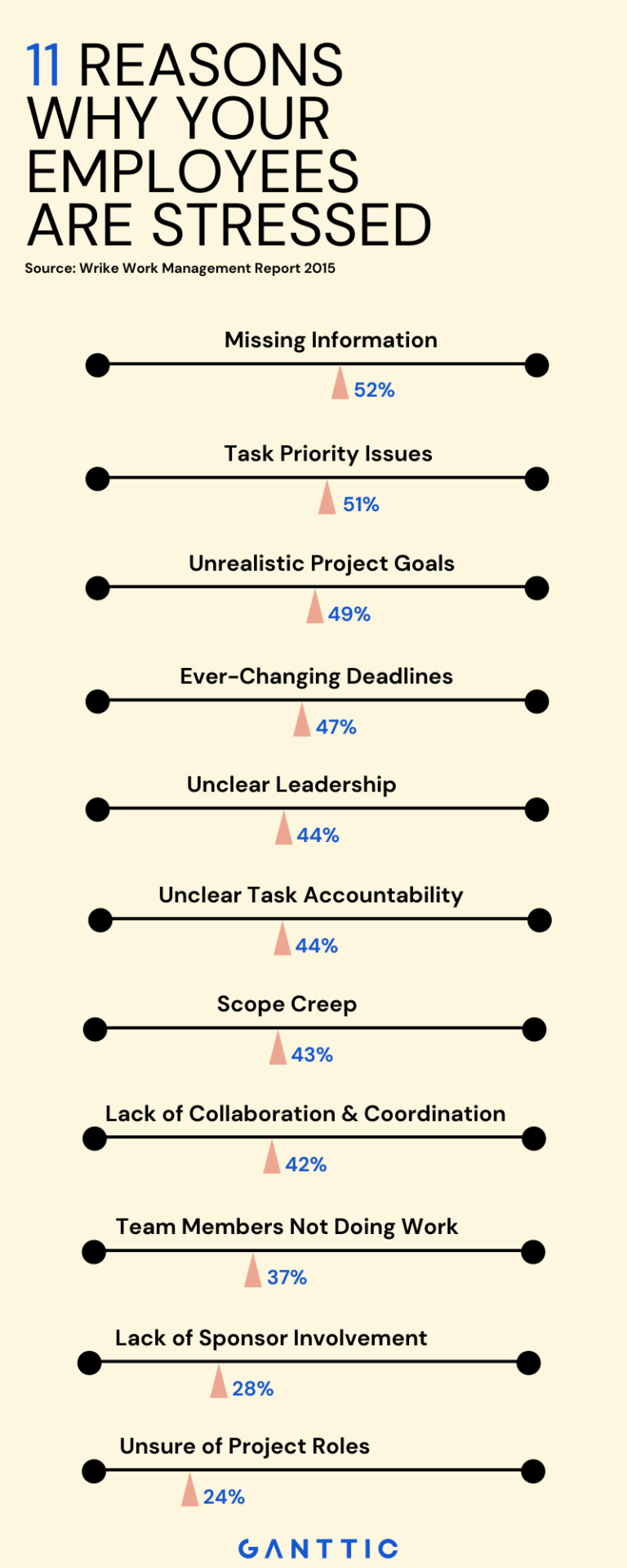Stress is a killer. Literally. Manifesting in all sorts of ways that can harm your employees, teams, and productivity, the most serious of which is death. And the worst part is that most of the time, it is unavoidable. Since the majority of workplace stress occurs from poor project management practices and improper communication channels.
So to protect your team from stress and its negative impacts, it’s in your best interest as manager to root out the causes of stress in your workplace.
That’s why we created an infographic highlighting the top 11 causes of workplace stress. With a few tips on how to reduce these sources of stress with some resource planning practices. These are some ideas to get you started on a stress free 2022. For you and your team.
What is Stress?
Stress is your body’s way of dealing with a particular demand. And is actually not a single response, but a sum of symptoms that manifest in a variety of ways.
It can be caused by pleasant or unpleasant stimuli. And this ultimately affects how it shows up for each individual.
Did you know that how a person reacts to stress can also determine how successfully they deal with change? Meaning we may not all be cut out for change management. To aid those who aren’t so adept with change, we have an article on how to initiate change and make the process tolerable for your team. As well as some communication techniques for change management.
Signs of Workplace Stress
Stress can appear as a mix of physical and psychological symptoms. Everyone has their own unique reaction. And another person’s stress is not always apparent. Below are some common ways that workplace stress can rear its ugly face.
- Fatigue
- Headache
- Stomach
- Muscle tension
- Change in appetite
- Teeth grinding
- Dizziness
- Irritability or anger
- Feeling nervous
- Lack of energy
- Feeling as though you could cry
Stress impacts every part of a person’s body – from the central nervous system, to digestion, reproduction, respiratory, and immunity. Meaning chronic stress can affect your entire well-being.
Workplace stress statistics
- 77% of Americans regularly experience physical symptoms caused by stress
- 16% of people saying that they’ve quit a job because of the associated work stress
- 30% of people say they are “always” or “often” under stress at work
- 48% feel as though their stress has increased over the past 5 years
Why Reduce Workplace Stress?
When you have an office full of stressed out employees, you may not always notice the symptoms, but you’ll definitely notice its impact. Here’s just some of the ways that stress can impact the work environment and activities.
Lower productivity – Less output, lower ROIs, unhappy workers, and unhappy clients. Stress ultimately impacts every part of your team’s work process.
Higher turnover – Stressed workers are more likely to quit. A high turnover can eat into the time and effort of your HR department. And is equally negative for team dynamics.
Higher workplace costs – In 2018, US employers lost more than $617 billion to employee turnover. Couple that with the $300 Billion in annual costs employers pay for stress related health care and missed work, and you’ll see why stress is no small matter for businesses.
Death – But as much as stress impacts workplace costs, it’s also responsible for the immeasurable cost of a human life. It’s estimated that 120,000 deaths per year can be attributable to how U.S. companies manage (or mismanage) their work forces.
Is Project Management Stressful?
I think you already know the answer to that.
A good project manager not only has their job to do, but also that of team mates who aren’t picking up the slack. They’re also the ones taking on the stress of deadlines, and smoothing any issues that develop along the way. Plus, when something goes wrong, who do you think gets blame?
It’s these reasons and more that 40% of surveyed project managers reported that they routinely suffer from prolonged stress in their jobs.
But of course stress is inevitable. And eliminating and managing stress is expensive for both employers and employees. A more effective solution is reducing the causes of stress.
11 Reasons for Project Management Stress
Now that we answered some of the basics about stress, we’ll look at a few of the top causes of stress in the workplace. And go into some detail as to what this means for your team.
Here’s our infographic on 11 main reasons stress transpires within project management process.

Let’s take a closer look at how these issues arise.
Reason for Stress: Miscommunication
By far the biggest source of stress for teammates is miscommunication. With 52% of respondents citing lack of information, 42% accusing a lack of collaboration, and another 24% who are unsure of their own role in the project.
Miscommunication is frustrating for everyone involved in collaborative projects. And it’s something that has only been exasperated with the rise of remote work. Because emojis don’t always convey how we feel.
How to Reduce this Stressor:
Gantt charts and Kanban boards are the most commonly used project management tools for a reason. They visually communicate what needs to be done to your whole team. And cloud-based versions can be deployed quickly and cheaply, meaning your team will never again question what they need to do.
Reason for Stress: Lack of Accountability
Coming in with 44% and 37% of the respondents’ votes for top workplace stressors, is unclear task accountability and team members not doing their work.
This can mean that PMs are not making it clear what their teams need to be doing. And who actually does what. Which can go on to lead other issues with efficiency down the road.
Plus, when others aren’t pulling their load, team dynamics start to break down. Causing stress and hostility amongst members.
How to Reduce this Stressor:
Hold people accountable by showing them what they need to do. Basic project resource management practices used by the PM can help alleviate this stress by allocating tasks to specific people.
If you use resource planning software, you create an overview of the entire team. Meaning no one can get away with not doing their individual tasks. Plus, extra features like deadlines, tasks’ dependencies (clearly indicating which tasks come first) and project milestones make it easy to see that everything is on track.
Reason for Stress: Project Scheduling and Timeline Issues
Problems arising from project scheduling cause stress for 49% and another 47% of respondents, citing unrealistic project goals and ever-changing deadlines respectively. Not surprisingly, unrealistic timeline expectations are also a main reason why projects end up failing.
Things like changing deadlines can be made worse if your team isn’t used to using a proper project planning tool. Because making and communicating changes to a spreadsheet isn’t only stressful for your team. But it’s stressful for you as PM.
How to Reduce this Stressor:

Engaging in some bottom-up estimating techniques such as analogous estimating can help you figure out exactly how long past tasks took. Use these figures to then more accurately estimate your current tasks’ duration. And plan projects with more precision.
And if you do find out down the road that you need to make changes to your project’s dates. Don’t worry! If you’re using resource planning software, just click on a task and make some adjustments.
You can also encourage staff to meet these deadlines by creating a milestone program for employees. When an employee reaches a key milestone, such as handing in a vital part of the project, you give them a gift or another incentive.
Read on: If you’re used to Excel for project and resource planning, we put together a list of spreadsheet alternatives you might want to consider instead.
Reason for Stress: Leadership Issues
All teams, no matter their size, require a leader. Giving the extra push, show of support, or insight needed to get the job done. Without effective leadership, employees are more prone to stress. With 44% citing unclear leadership and 28% accusing lack of involvement from project sponsors to be known stressors.
How to Reduce this Stressor:
When it comes to getting project sponsors more involved, there’s not always something you can do. Though you can try!
There’s a number of ways to engage your project sponsor. Such as keeping them in the loop on project progress. Sharing project plans or sending them reports can help them feel more involved from the outset, so that they eventually become more involved.
Reduce Stress in Project Management

Stress kills. It kills motivation, productivity, projects. Even people. But you don’t have to let it.
The best way to reduce your workplace stress is with proper project resource management techniques and tools. When you engage in employee planning with software like Ganttic, you ensure that your team members know exactly what they need to do and they have the right amount of work scheduled. That reduces stress for your team. And for you. Win, win!